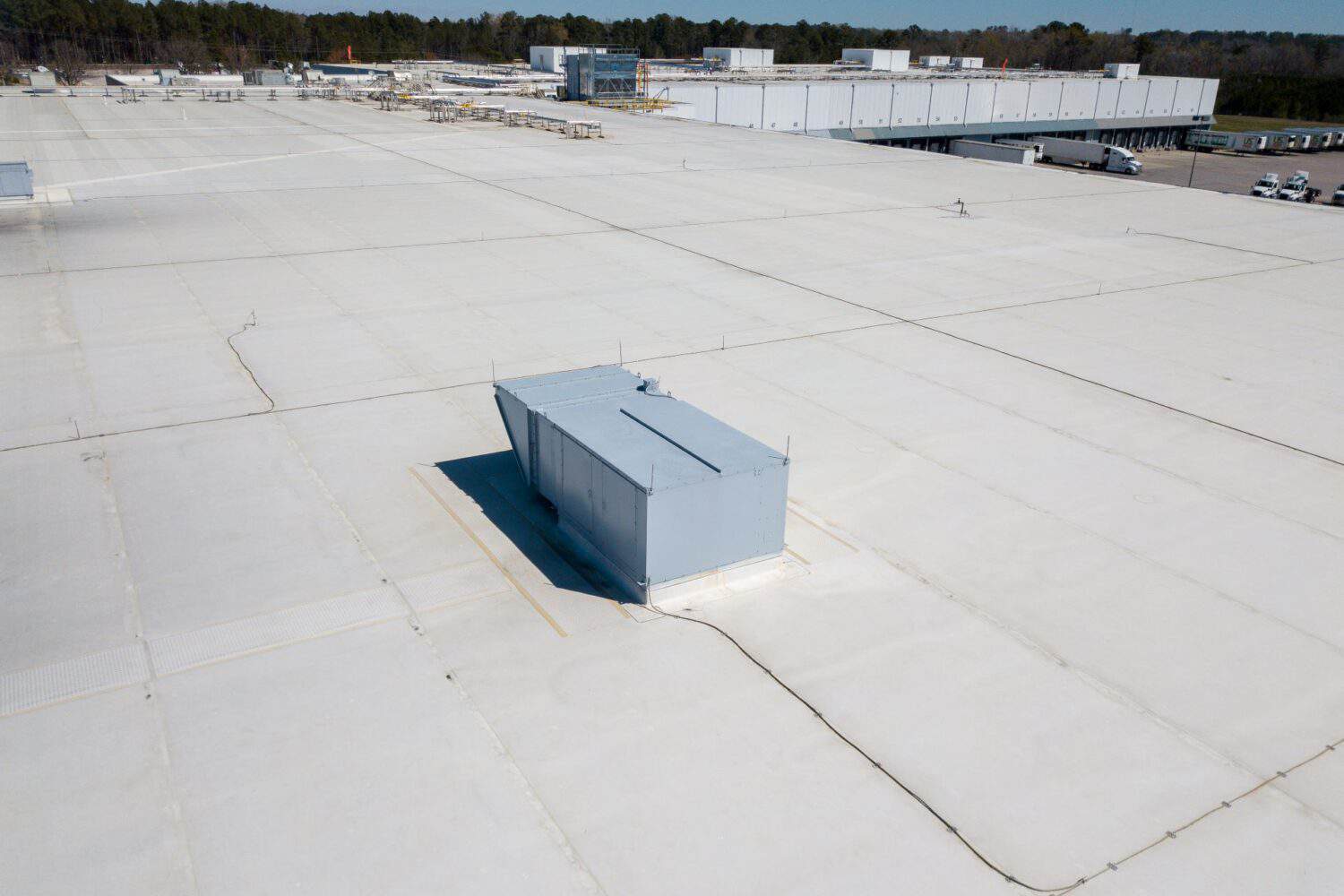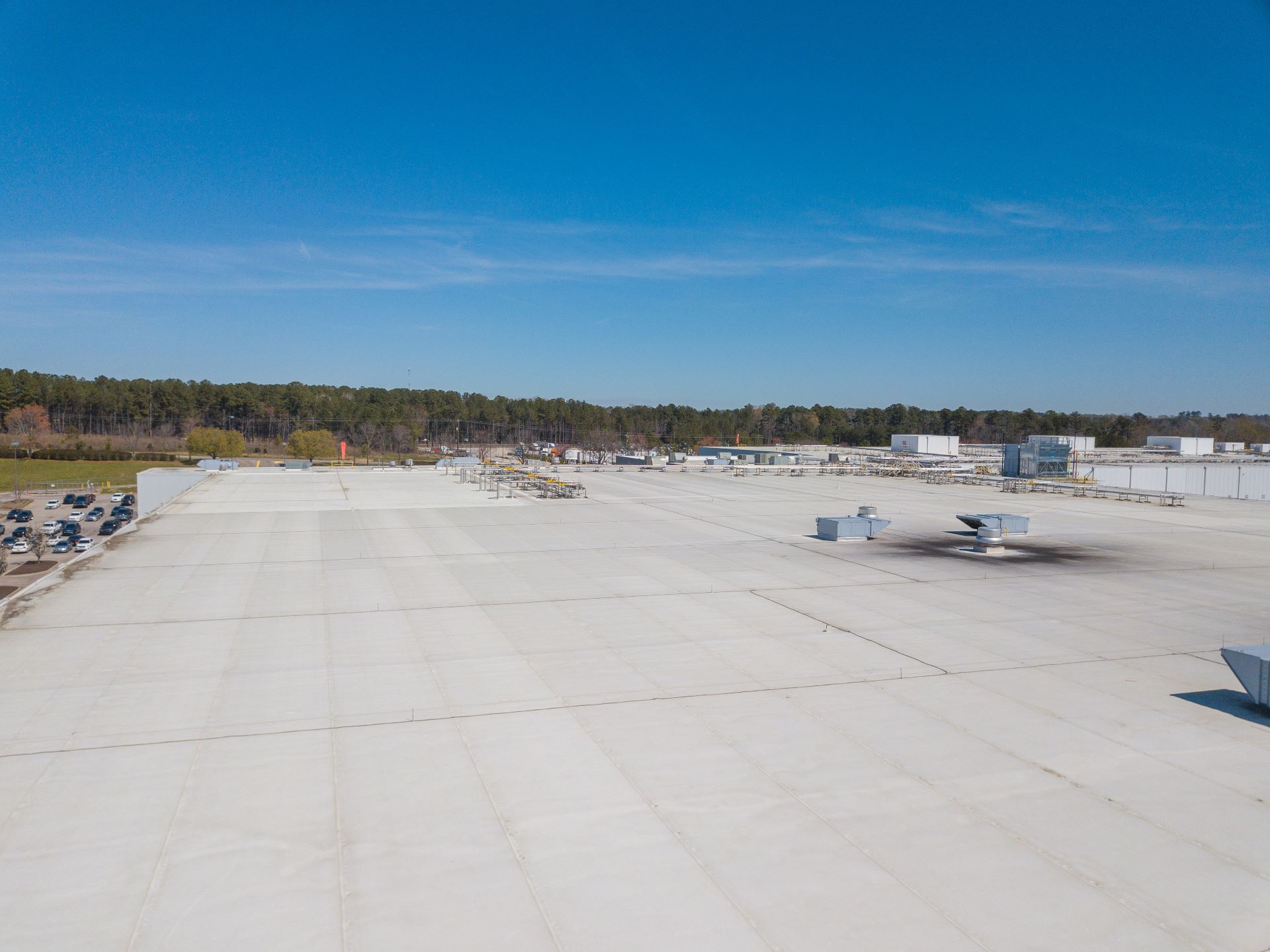Flat or low-slope roofs are mostly found on commercial buildings, but have seen some growth recently in residential construction due to their contemporary aesthetic, energy efficient properties, and cost-effectiveness. If you are a commercial property owner or manager, or a residential homeowner drawn to flat roof designs, or simply researching cost effective energy efficient roof options, TPO Roofing is worth considering. Let’s dig into TPO Roofing so you can learn all there is to know about this modern, flat roof construction option.
Let’s take a look at:
- What TPO Roofing is
- The benefits of TPO Roofing
- The Installation process
- Maintenance and repair considerations
- Cost considerations
What Is TPO Roofing?
TPO Roofing is made of the synthetic material, Thermoplastic Polyolefin or TPO for short. It is a single-ply roofing membrane used in flat or low-slope roof construction. TPO is an innovative material made from a chemical compound called polypropylene, which is known for both its elasticity and durability and used in many different types of products. For roofing, it is especially useful because it is designed to expand and contract with temperature changes, which makes it suitable in variable climates. It is also a water-repellent material, which is always a good characteristic for a roofing material.
TPO Roofing is manufactured to come in sheet rolls, ranging from 10, 12, or 20 feet wide and is naturally a bright white color, making it highly reflective. It was first developed in Europe in the late 1980s and was first used in the US in the early 1990s. It has since become one of the fastest-growing and most popular roofing systems used for flat commercial roofing construction. The increased popularity of the TPO Roofing system has much to do with its naturally reflective properties that make it ideal for reflecting UV rays and heat.
TPO Roofing: The Benefits
Strength and Durability
The TPO Roofing system is a durable flat roof option. If professionally installed by a roofing contractor who knows what they are doing and properly maintained, a TPO flat roof can last up to 30 years. The synthetic material of TPO makes it resistant to mold and dirt. Overall, when compared to other synthetic roofing materials, such as EPDM rubber, it is also more resistant to punctures and tears due to debris, foot traffic, or regular wear and tear.
High Energy Efficiency
One of the main benefits of a TPO Roof is its energy efficiency. The TPO membrane has a naturally white surface, which acts as a reflector of the sun’s UV rays. Most other flat roofing systems use black materials, such as bitumen or asphalt, which absorb the sun’s rays instead of reflect them. This can add heat to a building’s interior, especially in the warmer summer months, and make cooling systems work harder to keep interior temperatures comfortable. In this way, TPO roofing materials can improve a building’s energy efficiency and therefore lower energy costs too.
Customized Choices
Another benefit of TPO Roofing is the level of customized choices you can make with installation. This includes the type of roofing insulation that can be used as well as the different systems that are on the market, including GAF TPO, GenFlex or Carlisle. The material itself also comes in different color options, depending on the manufacturer, allowing for more flexible design choices.
High Fire Rating
The synthetic make-up of TPO membranes make it possible to have fire retardant chemicals added during manufacturing. This can earn TPO Roofing a Class A fire resistance rating.
Ease of Installation
The large manufactured rolls of TPO Roofing make it easier to install than other flat roofing systems. The rolls can be more easily transported to the rooftop and then unfurled on the roof deck where the seams are then hot-air welded in place to ensure a waterproof seal.
Cost-Effectiveness
TPO Roofing material is less expensive than other thermoplastic materials or EPDM rubber. A product that provides easy installation usually also comes with lower labor costs because it does not take as long to install and is usually also less hazardous. The combo of easy installation and durability coupled with less expensive materials, makes TPO Roofing a cost-effective flat roofing option.
The Drawbacks of TPO Roofing
All roofing options have their cons to go along with their pros. TPO Roofing is no exception. Making a roofing choice is usually an expensive investment, so being aware of both the advantages and disadvantages of the material upfront is important. Despite its popularity, some of the main drawbacks of a commercial TPO Roof are:
- Prone to needing leak repair as it ages
- Must be professionally installed by a properly trained roofer
- Susceptible to ice collection during winter months in colder climates
TPO Roofing: The Installation Process
The TPO Roofing installation process is easier than many other flat roofing options. Since the TPO Roofing Membrane comes in rolled sheets it is easier to transport and get up to the top of buildings during construction, but it is not a DIY project that can be done by an untrained maintenance worker. Installing a TPO Roof incorrectly can cost a lot of money down the road. Hiring a professional roof installer who is trained in the proper installation methods of TPO Roofing is vital to your roof providing the protection it is designed for and your building deserves.
Roof Preparation
The first step in the installation process is to prep the existing roof. This includes cleaning the roof surface and removing any previous roof covering.
Installing Insulation
The next step, before laying down the TPO Membrane, is adding roof insulation. There are three main types of insulation used for TPO flat roofing. These include:
- Polyisocyanurate (Polyiso)
- Expanded Polystyrene (EPS)
- Extruded Polystyrene (XPS)
There are pros and cons of using each of these insulation options.
Polyiso uses less toxic and eco-friendlier flame-resistant chemicals in manufacturing than the other types of insulation. It is also more expensive than other options and more water absorbent.
EPS and XPS are both rigid foam insulation made from polystyrene and are flexible to work with. Both are also not considered eco-friendly. They degrade very slowly and are harder to recycle and dispose of.
EPS has low thermal conductivity and high moisture resistance. It is the cheapest of the three insulation options, but is also more fragile and susceptible to pest and rodent infestation.
XPS is highly moisture resistant and has high compressive strength and low thermal conductivity. It performs well in areas that experience temperature extremes. It is the most durable and damage resistant of the insulation options, but it is more expensive than EPS and can be harder to install.
Installing the TPO Membrane
Once the insulation is laid, the next step is to install the TPO Membrane. The membrane is rolled onto the roofing surface and secured to the cover board with an adhesive. The installation process is completed by hot air welding the membrane seams together. This creates a protective, waterproof seal across the roof expanse.
TPO Roofing: Maintenance and Repair Considerations
No matter what type of roof you have, an annual roofing inspection by a qualified, professional roofing inspector is imperative. It’s the first step in any roof maintenance plan. A roof inspection can catch problems before they become too costly or start to cause interior damage to your building.
Common TPO Roofing issues that can arise include ripped seams, failed flashings, and punctured or torn membranes. Over time, TPO Roofing seams can lose adhesion to the roof deck, which can cause water to seep into the insulation. This can cause damage to the roofing deck and eventually cause interior leaks. The main job of a roof is to provide water-tight protection for the building’s interior from weather and the elements. If your roof is leaking, it is not doing its job and is a sure sign repair or replacement is required.
If during inspection damage is discovered but it is determined that the roof can be repaired instead of replaced, then it is important to get the repairs done quickly to avoid further damage.
A typical TPO Roof repair involves a silicone restoration. In this process the damaged roof areas are removed and replaced. The TPO Roofing seams will also be reinforced and a silicone coating will be applied to the entire roof surface to prolong the roof’s lifespan.
TPO Roofing: Cost Considerations
A commercial TPO Roof will run between $5 to $12 per square foot, depending on several factors. A typical TPO Roof cost is determined by:
- The size and condition of your roof
- The type of TPO Roofing materials you choose, including insulation and membrane types
- Ease of access to your roof
- Type of warranties available
- How you choose to have it installed
The Final Word on TPO Roofing
Flat or low-slope roofs do require different construction materials and methods than higher sloped roofs. Since its introduction over 30 years ago the popularity of TPO Roofing has grown among commercial property owners and managers as well as residential homeowners looking for flat roof design options. Its reflective properties and less expensive material costs make it a cost-effective, energy saving roofing system that will last up to 30 years with proper care and maintenance.


